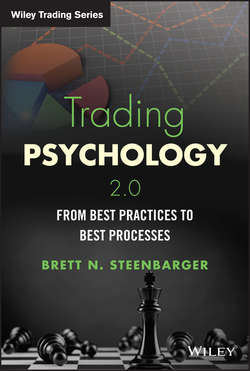Trading Psychology 2.0

Реклама. ООО «ЛитРес», ИНН: 7719571260.
Оглавление
Steenbarger Brett N.. Trading Psychology 2.0
Epigraph
Preface
Introduction
Prelude
Chapter 1. Best Process #1: Adapting to Change
Emil's Restaurant
The Single Greatest Barrier to Adaptation
The Power of Flexible Commitment
Flexibility and Trading
The Rebuilding of Maxwell
The Perils of (Over)Confidence
Tapping Core Motivations
Why Discipline Doesn't Work
The Purpose of Purpose
Turning Adaptation into a Routine
The Limits of Trader Discipline
The Emotionally Intelligent Trader
Readiness for Change
Self-Assessment Exercise
Tapping the Sense of Urgency
See-Feel-Change: The Importance of Optimism
The Dangers of Trader Isolation
Changing the Internal Dialogue
The Perils of Perfectionism
Relapse
Summing Up: Moving from Contemplation to Action
Taking and Sustaining Action: Identifying Opportunity
Self-Assessment Exercise
Taking and Sustaining Action: Identifying Threats
Where to Look for Fresh Directions
Chapter 2. Best Process #2: Building on Strengths
The Trader in a Slump
Why Strengths Are Key to Performance
Finding Strengths in the Smallest Places
What Are Your Strengths?
Self-Assessment Exercise
How Strengths Interact to Create Successful Experience
What Strengths Don't You Possess?
Can Your Strengths Also Be Weaknesses?
Making Our Strengths Stronger
The Excellence Principle
Making a Habit of Developing the Right Habits
A Look at Character Strengths
Higher-Order Integration of Strengths
Revisiting Multiplier Effects in Development
Subjective Well-Being: The Most Important Emotions in Trading Psychology
Self-Assessment Exercise
Well-Being and Personality
What Research Teaches Us about Well-Being
How Can We Cultivate Well-Being?
Eliminating Drains on Our Energy
Conscientiousness: The Underappreciated Ingredient of Success
Biofeedback as a Strategy for Enhancing Well-Being
Using Meditation to Build Positivity
Using Self-Hypnosis to Feed Positivity
A Workout for Mind and Body
Special Topics in Well-Being: Love
Special Topics in Well-Being: Affinity Groups
Special Topics in Well-Being: Gratitude
Putting It All Together: Trading, Strengths, and Well-Being
Chapter 3. Best Process #3: Cultivating Creativity
The Trader as Entrepreneur
Allen, the Trading Entrepreneur
The Success of the Trading Entrepreneur
Trading and the Crisis of Management
Trading and the Crisis of Creativity
Creativity Provides Food for Our Strengths
What Is the Creative Process?
Finding Problems as Part of Finding Answers
Can We Become More Creative?
Trading Failure and the Downhill Spiral of Creativity
The Essence of Creativity: Reframing Problems
The Skills of Creativity: Switching Modalities
The Skills of Creativity: Increasing the Productivity of Our Thought
The Skills of Creativity: Finding Fresh Combinations
The Skills of Creativity: Thinking by Analogy
Creativity and Lifestyle
Creativity in Groups
Does Brainstorming Work?
Tapping into Group Creativity Even When You Are Independent
The Single Greatest Barrier to Creativity
It All Fits Together
Chapter 4. Best Process #4: Developing and Integrating Best Practices
What Are Best Practices?
Linking Best Practices into Best Processes
Steps Toward Becoming a Process-Driven Trader
How Many Trading Firms Are Truly Process-Driven?
How Can Individual Traders Be Process Driven?
Conducting a Process Review of Your Trading Business: Twenty Sets of Questions
A Few Observations on Process Improvement
Fifty-Seven Best Practices for Trading Success
Summary
Conclusion: From Best Practices to Best Processes
Postscript
References
Further Resources from Brett Steenbarger
About the Author
Отрывок из книги
Trading Psychology 2.0
From Best Practices to Best Processes
.....
A small example of paradigm shift in psychology occurred when the reigning framework of psychoanalysis gave way to more active, directive, briefer forms of intervention. Psychoanalysis was – and remains – an elegant theoretical framework with explanatory power. Freud's core idea was that present-day problems are reenactments of past, unresolved conflicts. The goal of therapy was to reenact those conflicts within the helping relationship, allowing the analyst to provide insight into the repetition compulsion. Once patients became aware of their repetitions, they could change those patterns within the therapeutic relationship and, from there, within their other relationships. As you might expect, analysis was a long-term affair, requiring time and effort to achieve insight, wrestle with conflicts within the therapy, and then work through those conflicts in present and past relationships. In the heyday of analysis, it was not unusual for therapy to require multiple sessions per week over a period of years.
As it happens, people do repeat conflicts and issues throughout their lives – in their marriages and in their trading. What therapists found in their practice, however, were Kuhnian anomalies. Some clients described vexing, long-standing problem patterns and yet managed to change them within a matter of days and weeks – not months and years. Pioneering therapists such as Alexander and French and Milton Erickson began to explore these accelerated change processes and question core tenets of psychoanalysis. What they found was powerful emotional experiences could catalyze relatively rapid change. My life turned around, not because of any grand insight accumulated over years of analysis, but from the single powerful influence of meeting the woman who would become my wife and the children who would form my new family. Anomalies had built to a crisis point in my life, and it was out of the deep emotional recognition of personal, social, and career limitations that I became ready for wholly new commitments.
.....